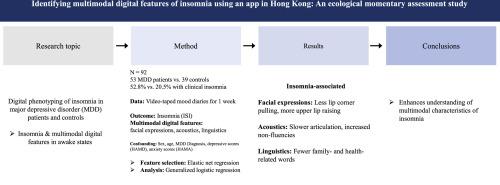Identifying multimodal digital features of insomnia using an app in Hong Kong: An ecological momentary assessment study
IF 3.4
2区 医学
Q1 CLINICAL NEUROLOGY
引用次数: 0
Abstract
Background
Digital phenotyping of insomnia remains underexplored, particularly in the context of depression, despite the high comorbidity between these two conditions. This study aims to investigate the associations between insomnia and multimodal features using active data collection during awake states, including facial expressions, acoustic characteristics, and language use.
Methods
A sample of 92 participants was recruited, 39 % of them presented with clinical insomnia as measured by Insomnia Severity Index. Multimodal features were extracted from video-taped mood diaries recorded for one week. We analyzed the associations between multimodal features and insomnia using generalized logistic regression models, while controlling for demographic data, psychiatric diagnosis, scores of depression and anxiety.
Results
Insomnia was associated with facial, acoustic, and linguistic features, included less lip corner pulling, more upper lip raising and lip corner depressing, slower articulation rate, increased non-fluencies and the use of fillers, fewer family- and health-related words.
Conclusions
The current findings enhance our understanding of the multimodal digital phenotypic characteristics of insomnia, facilitating a more objective assessment in future research.

在香港使用应用程序识别失眠的多模态数字特征:一项生态瞬时评估研究
尽管失眠和抑郁症之间存在很高的合并症,但失眠的数字表型仍未得到充分研究,尤其是在抑郁症的背景下。本研究旨在通过在清醒状态下收集包括面部表情、声学特征和语言使用在内的主动数据来研究失眠与多模态特征之间的关系。方法采用失眠症严重程度指数(insomnia Severity Index)对92例临床失眠症患者进行调查,其中39%的患者表现为临床失眠症。从记录了一周的录像情绪日记中提取多模态特征。我们使用广义逻辑回归模型分析了多模态特征与失眠之间的关系,同时控制了人口统计数据、精神病学诊断、抑郁和焦虑评分。结果失眠与面部、声学和语言特征有关,包括唇角拉得少、上唇抬高和唇角凹陷多、发音速度慢、不流利和使用填充物增加、家庭和健康相关词汇减少。结论本研究结果增强了我们对失眠多模态数字表型特征的认识,有助于在今后的研究中更加客观地进行评估。
本文章由计算机程序翻译,如有差异,请以英文原文为准。
求助全文
约1分钟内获得全文
求助全文
来源期刊

Sleep medicine
医学-临床神经学
CiteScore
8.40
自引率
6.20%
发文量
1060
审稿时长
49 days
期刊介绍:
Sleep Medicine aims to be a journal no one involved in clinical sleep medicine can do without.
A journal primarily focussing on the human aspects of sleep, integrating the various disciplines that are involved in sleep medicine: neurology, clinical neurophysiology, internal medicine (particularly pulmonology and cardiology), psychology, psychiatry, sleep technology, pediatrics, neurosurgery, otorhinolaryngology, and dentistry.
The journal publishes the following types of articles: Reviews (also intended as a way to bridge the gap between basic sleep research and clinical relevance); Original Research Articles; Full-length articles; Brief communications; Controversies; Case reports; Letters to the Editor; Journal search and commentaries; Book reviews; Meeting announcements; Listing of relevant organisations plus web sites.
 求助内容:
求助内容: 应助结果提醒方式:
应助结果提醒方式:


